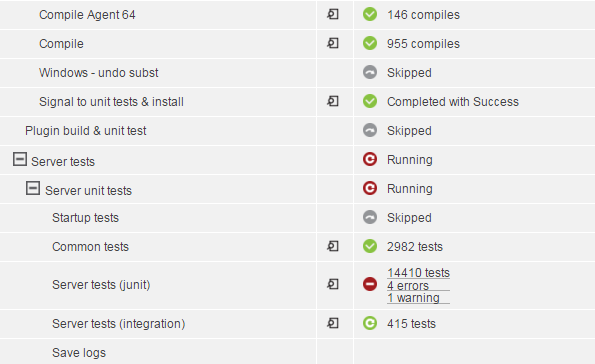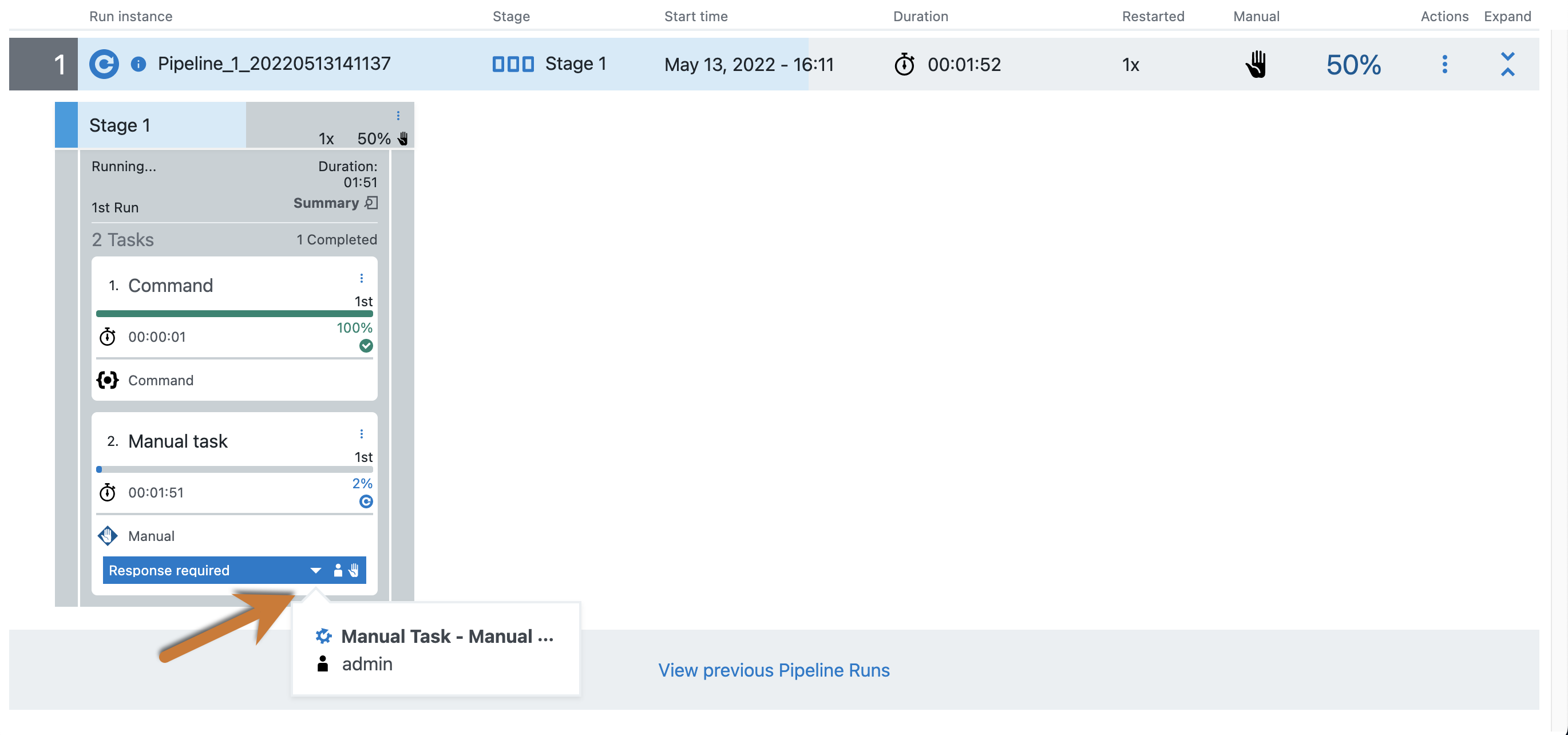From the Release Dashboard
The Release Dashboard orchestrates all information about planned, active, or completed releases and displays releases you have permission to view in one place. At any time, you can view:
-
Current status of the release.
-
Where the release is in the process flow.
-
Any errors during the runtime.
-
Where human intervention is required to take action, perform a task, or grant approvals.
-
The start and end dates and times for the release.
CloudBees added start and end times with v.2023.02.0. This information is not backward compatible in DSL. You cannot import generated DSL of release objects from v2023.02.0 to earlier versions without manual changes.
For more information, refer to Release dashboard. Refer to Example: Visibility in a Release Pipeline from the Release Dashboard for an example of how to drill down from the top pipeline run view to the specific job details of the release tasks.
For a release that is in progress or has been completed, select the Release status to open the Pipeline Run view. You can view the Stage Summary for the latest release or view previous pipeline runs. The Stage Summary shows the pipeline’s progress through each stage and evidence that the tasks were executed. Select in a stage task or a gate to display its Stage Summary. For more information, refer to Pipeline stage summary.
-
When the release is in progress, you can view the progress of the pipeline as it runs. Refer to Viewing the stage summary during a pipeline run for an example.
-
You can also view a completed pipeline run. Refer to Viewing the stage summary for a completed pipeline run for an example.
-
Selecting View previous Pipeline Runs displays the last five pipeline runs. After selecting one of these runs, you can view the Stage Summary to view more details about the pipeline run.
-
If the pipeline has errors, you can also view what the error is and where it occurred in the pipeline in the Task Error view.
For example, you can view the progress and evidence of the deployer task run. Selecting ![]() displays the payload of the release. This is the actual list of applications or microservices (and the number of applications or microservices) to deploy that is specified in the bill of materials in the release definition.
displays the payload of the release. This is the actual list of applications or microservices (and the number of applications or microservices) to deploy that is specified in the bill of materials in the release definition.
From the Release dashboard, you can go to the Path-to-Production view for running or completed releases. This view shows the bill of materials for the release. You can view the artifacts and snapshots that are in compliance with the release manifest. For more information, refer to Path to production view.
From the Environment Inventory
The Environment Inventory shows what is deployed in an environment at any time. For more information, refer to Environment inventory.
From the Change History
The Change Tracking feature tracks changes between every state of non-runtime objects, such as environments and resources. CloudBees CD/RO records a Change History of the historical states of environment objects, including environment tiers and resources, and records changes between them. For more information, refer to Change Tracking.
Postp
Postp, a postprocessor included with CloudBees CD/RO, is used for data collection and for report generation. For visibility in a release run, you can get live streaming data from the log files using the standard output settings. Using postp commands in pipeline tasks (defined by application or microservice processes, procedures, or workflows), you can make this data appear in the Job Details page in CloudBees CD/RO.

This example shows:
-
During the Compile step, there were 955 compiles.
-
In the "Command tests" step, 2982 tests were run.
-
For the "Server tests (junit)" step, 14410 tests were run with 4 errors and 1 warning. Selecting on the links in this step provides details and evidence about how the job ran and what actions to take next.
Selecting on the log button for any of these steps displays the log file details.
For more information about using postp:
-
Refer to Editing a pipeline definition to define, view, and edit pipeline tasks in the pipeline definition.
-
Refer to Postprocessors: Collecting data for reports to configure data collection, generate reports, and display data from log files.
For an in-progress release
You can view the progress of the pipeline during the Release run starting in the Release Dashboard:
-
In the Release dashboard, selecting on the status of an in-progress or completed Release opens the Pipeline Run view for the Release pipeline.
-
When manual intervention is needed at a gate (indicated by the
 hand menu), selecting the menu displays the required approvals. Selecting the specific approval opens the gate approval dialog.
hand menu), selecting the menu displays the required approvals. Selecting the specific approval opens the gate approval dialog.After the approval rules or conditions are approved, the pipeline continues.
-
When a pipeline stage is running, it is enabled. Select the Summary link to view the tasks in the stage and their progress.
-
In the Stage Summary, the top section shows information about the tasks deployed in the pipeline stage, which you can show or hide. You can also display user-generated information such as:
-
Links to websites for reports and other information about the deployed artifacts
-
Property information about the pipeline stage and the objects in it
-
-
The next section shows the tasks in the pipeline stage. If the pipeline is in progress, select the Response required menu item to view details for the manual task:
 Figure 2. View manual task details
Figure 2. View manual task details -
After completing the manual task, select Complete as the outcome, add a comment, and select OK in the Manual dialog box.
To view details about a completed manual task, select
 to view the details. The Manual dialog box opens. When the manual task has required input, select
to view the details. The Manual dialog box opens. When the manual task has required input, select  in the Parameters row to view the manual task details. The Manual dialog box now shows the action and evidence fields. The action field describes what was done to approve the manual task, and the evidence field describes what was done to approve it.
in the Parameters row to view the manual task details. The Manual dialog box now shows the action and evidence fields. The action field describes what was done to approve the manual task, and the evidence field describes what was done to approve it. -
When human intervention is needed at the exit gate (indicated by the hand icon), an exit gate is enabled. Selecting in the exit gate displays the approvals required to complete the pipeline stage.
-
If the entry gate to the next stage has approval conditions before the tasks in it can start, this entry gate is enabled. Selecting in the entry gate displays the approvals required to start the tasks in a pipeline stage.
-
The sequence continues as the pipeline progresses.
-
Select View previous Pipeline Runs to view the previous five runs.
Select
 to display the pipeline, where you can select in a gate or stage to view more details. Select
to display the pipeline, where you can select in a gate or stage to view more details. Select  to hide this pipeline.
to hide this pipeline.To view details about a manual task, select
 to view the details of the manual task. The Manual dialog box opens. When the manual task has required input, select
to view the details of the manual task. The Manual dialog box opens. When the manual task has required input, select  in the Parameters row to view the manual task details. The Manual dialog box now shows the action and evidence fields. The action field describes what was done to approve the manual task, and the evidence field describes what was done to approve it.
in the Parameters row to view the manual task details. The Manual dialog box now shows the action and evidence fields. The action field describes what was done to approve the manual task, and the evidence field describes what was done to approve it.To view details about the other pipeline tasks, select
 to view the Job Details.
to view the Job Details.
-
-
For a Completed Release
Refer to Run and end releases for an example of running and completing a release.